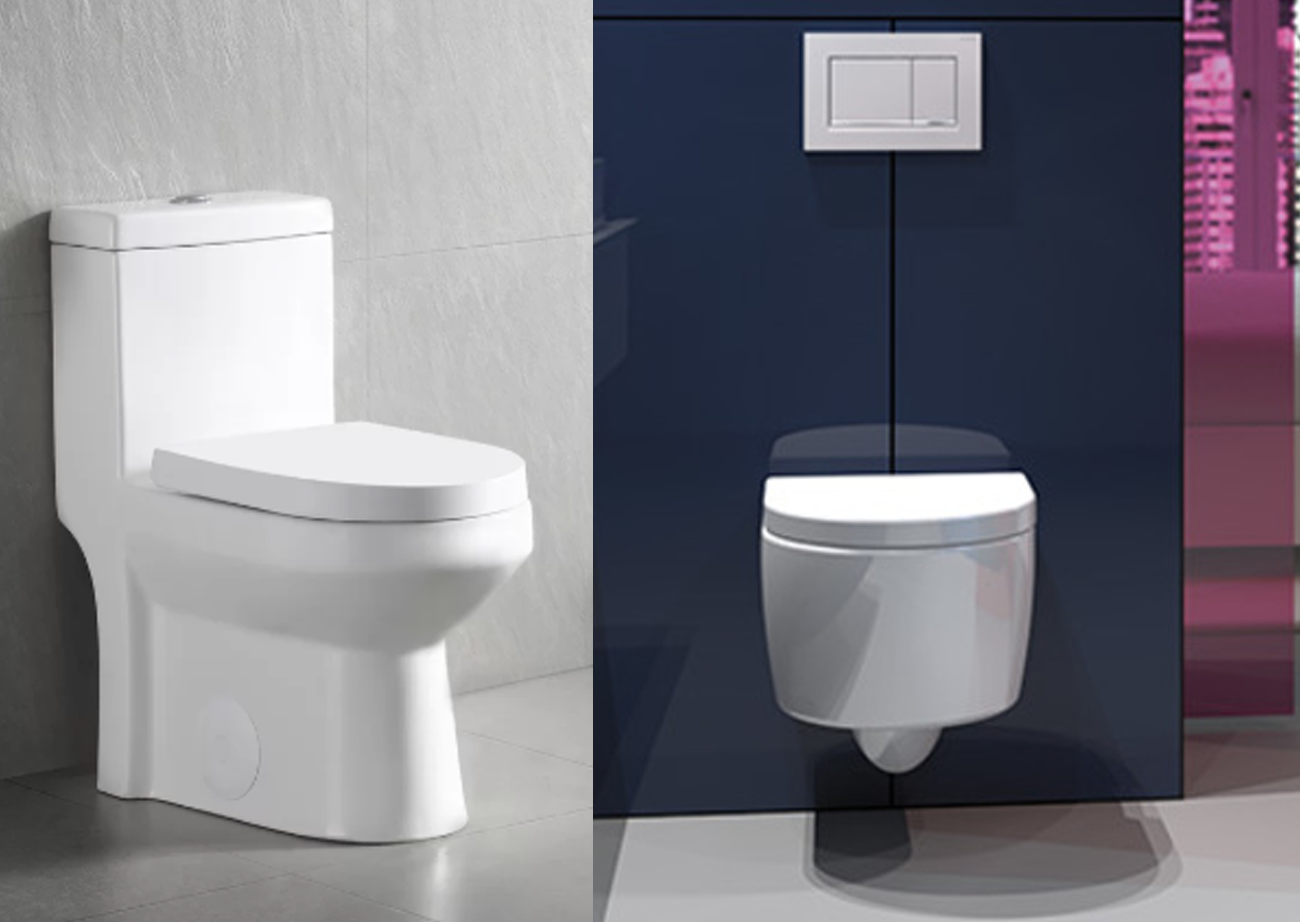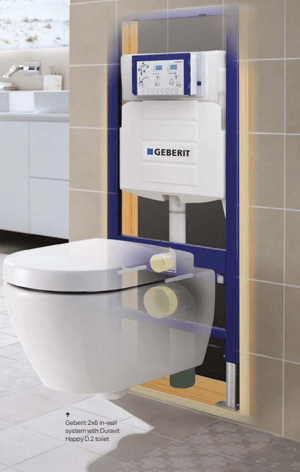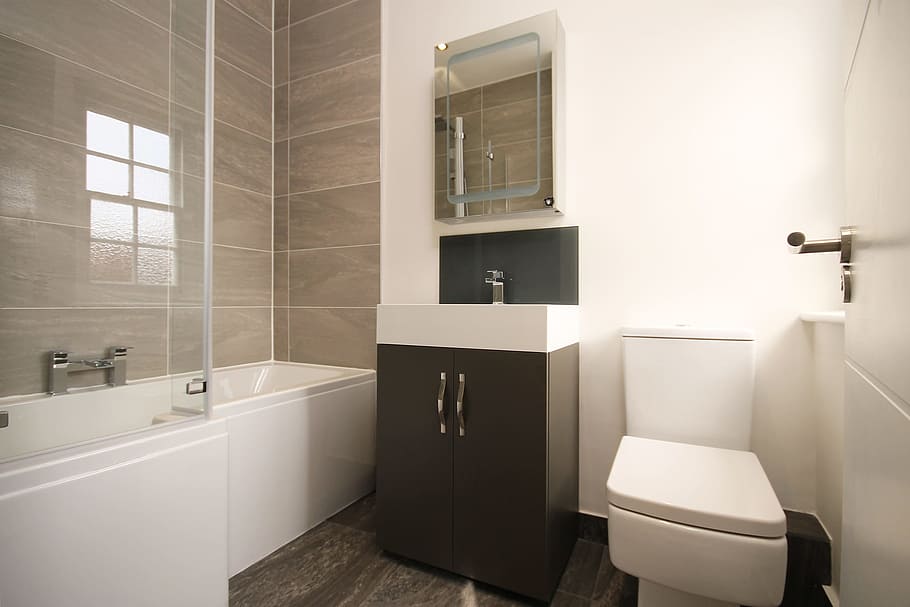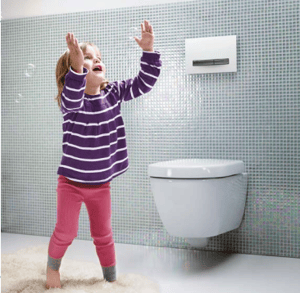
Bathroom design doesn’t have to be ho-hum. If your style is sleek and modern or more traditional, if you embrace the clean look of white or crave color, or if you have a brand-new home or are working on a historical renovation, there is a toilet for you. And finding it can be just as fun as choosing other furnishings. If you want to know the difference between a standard toilet vs. a wall-mounted toilet, you’ve come to the right place.
What’s the difference between a wall-mounted toilet and a standard toilet?
The most obvious difference, of course, is that a wall-mounted toilet hangs on the wall and a standard toilet sits on the floor. With a standard toilet the tank is exposed, sitting atop the bowl. Conversely, the tank of a wall-mounted toilet is hidden inside the wall, in a frame that’s attached to the studs.
Your choice in toilets may be influenced by your style. A wall-hung toilet can look sleek and contemporary and is frequently preferred by minimalists. If you prefer a more traditional look, however, many ceramic manufacturers offer floor-mounted and wall-hung toilets to complement that style. But style isn’t everything. Sometimes the construction and operation of a fixture, the materials it’s made of, and installation and maintenance details dictate which is the right choice for the job. Let’s look at some of the pros and cons of each style to help you make the best choice for your bathroom renovation.
Pros and Cons of the Wall-Mount Toilet
Pros
Space savings: Most building codes require at least 21 inches of space in front of a toilet. The wall-hung toilet saves 9-12 inches of space because the tank is hidden in the wall. This makes it the perfect choice for tiny homes, small apartments, powder rooms — anywhere extra space is hard to come by. Geberit makes models to fit walls with both 2x4 and 2x6 studs.
both 2x4 and 2x6 studs.Water savings: If you have an older home with original plumbing fixtures, replacing your standard toilet with a wall-hung model can save thousands of gallons of water per year. Also, Geberit in-wall toilet systems offer built-in dual-flush: a full flush for solid waste and a reduced flush for liquids. The reduced flush uses less than a gallon of wat
Easy cleaning: With a wall-mount toilet, there’s no reason to worry about what lies beneath. Unlike a standard toilet, a wall-mounted toilet opens up the entire floor for easy cleaning with a damp mop.er, compared to the standard 1.28 gallons required of a new water-saving standard toilet.
Adjustable height: The seat height of a standard toilet is 15 inches from floor to seat, or 17-19 inches from floor to seat for ADA compliant models. When installing a wall-hung toilet, you can hang the bowl at virtually any height comfortable for you.
Accessibility: Hiding the toilet tank inside the wall adds 9 to 12 inches of linear space, improving access for people using walkers or wheelchairs. And the adjustable height makes a wall-hung toilet a superior option for people with disabilities.
Cons
Installation: Installing a wall-mounted toilet can intimidate do-it-yourselfers, though it’s not impossible for the skilled homeowner. (Geberit offers easy-to-follow installation instructions and spec sheets for all their toilet systems.) The tank and frame go inside the wall so you need to order the right size frame for your walls, either 2x4 or 2x6, and you’ll need to create an opening in the studs where the frame can fit. You’ll also need to move the plumbing lines for supply and wastewater. If you’re replacing an existing floor-mounted toilet, you’ll need to close up the hole in the floor.
Maintenance: Everything that makes a wall-hung toilet work is accessible behind the flush plate, which can be removed without tools. The only downside here is that most of the parts won’t resemble what you’ll find in a standard toilet. If you ever need replacement parts, you probably won’t be able to pick them up at the local home center or hardware store.
Price: When you buy a standard toilet, everything is included, with the possible exception of some installation parts like a supply hose and wax ring. For a wall-mount toilet, the tank and frame, flush plate, and bowl are sold separately.
Pros and Cons of a Standard Toilet
Pros
Installation: Installing a standard toilet, especially when you’re replacing an existing toilet, is an easy job for the DIYer. No cutting open walls or rerouting plumbing lines necessary.
 Maintenance: Everyone, a time or two, has taken the lid off a toilet tank and untangled the chain so the flap will close. But if your wall-mounted toilet needs repair, the knowledge you grew up with won’t fix it. In Geberit wall-mounted systems, however, removing the flush plate provides access to all the parts necessary for simple repairs.
Maintenance: Everyone, a time or two, has taken the lid off a toilet tank and untangled the chain so the flap will close. But if your wall-mounted toilet needs repair, the knowledge you grew up with won’t fix it. In Geberit wall-mounted systems, however, removing the flush plate provides access to all the parts necessary for simple repairs.
Variety: Traditional floor-mounted toilets are common in North America, so you’ll find lots of shapes, styles, and colors to choose from. Wall-mount toilets, on the other hand, aren’t available in such a wide variety, though more and more options are becoming available as this type of toilet gains popularity.
Cons
Not so easy to clean: A standard toilet gathers dirt in all its nooks and crannies. Spiders like to build their webs between the tank and the wall. Getting a mop behind the base is tricky and the seam around the base is a perfect hiding place for germs and dirt.
Sweating: When the temperature in the home is warmer than the water in the toilet tank, condensation forms on the outside of the tank. If this condensation is heavy, the water droplets can cause damage to the flooring underneath and mildew to form. Geberit wall-hung toilet tanks are made of seamless plastic that’s insulated to prevent sweating.
Unsightly tank: We’re so used to having the toilet tank in the room with us that we hardly notice it. But there’s no reason it should be there, any more than the water heater should be in the same room as the shower. A standard toilet tank sits in the bathroom, taking up valuable space and collecting dust, when it should be out of sight and out of mind.
Other Things to Consider When Choosing Your Toilet
You’re probably already wondering if a wall-hung toilet will support your weight. Geberit in-wall toilet systems are guaranteed to hold up to 880 lbs. (400 kg.) without deforming the frame or damaging the wall. Any properly installed Geberit system will easily hold the weight of the bowl and the person seated on it without sagging.
Whether you’re building a new home or renovating the bathroom in an existing home, choosing the right toilet for your style is important. Now, armed with everything you need to know, you can make the right decision.

